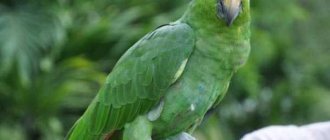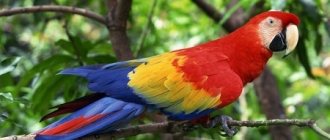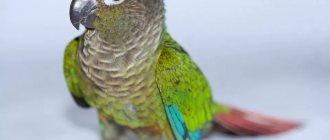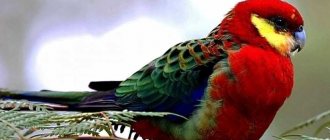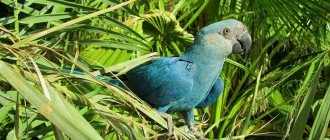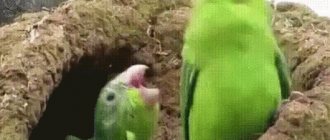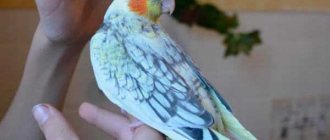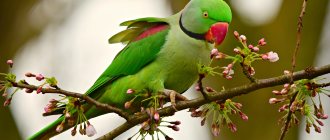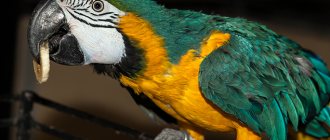After dogs, cats and fish, parrots take fourth place in the top favorite pets. About 14 million birds live in captivity in our country, most of them are parrots. And no wonder: acrobatic tricks, captivating colors and, often, interesting personalities - these birds are difficult to resist.
Pet parrots can be incredibly friendly towards their owners. Long-lived, intelligent, socially organized birds need increased attention and communication, otherwise they become boring and embittered.
Number of species in the world
Parrots are one of the most recognizable and attractive birds in the world. About 400 species of parrots exist in the world. They can be distinguished from other birds by their main characteristics.
This:
- powerful curved beak;
- paws with four toes, two of which are facing back, two - forward;
- ringing voice;
- bright color of plumage.
In our article we will look at the most common breeds of parrots with photos and names.
Nutrition
Despite its large size, powerful beak and claws, the red macaw is not a predator. Its diet consists mainly of plant foods. The parrot eats with pleasure:
- various nuts;
- seeds, nectar and flowers of plants;
- fruits and berries;
- bark of young trees;
- larvae and insects.
These birds even eat unripe fruits, the hard skins of which are removed with the help of their powerful beak.
On a note. There have been recorded cases of red macaws attacking farmers' fields and destroying almost the entire crop.
Large parrots often fly to river shallows and swallow silty soil enriched with mineral salts. In this way, red macaws neutralize toxins that are present in unripe fruits.
The most decorative
Of the variety of species of these amazing birds, it is difficult to single out those that are particularly beautiful and graceful. Therefore, the division is rather arbitrary. But still, there are several breeds that can charm even the most sophisticated bird connoisseurs with their attractiveness.
Ozherelovy
The main color of these parrots is light, pastel green. Other colors have also been bred through selection, so you can often see white birds of this species or rainbow ones on sale. But the familiar necklace parrots have precisely the light green color of their feathers. Africa is considered the homeland of this species. Life expectancy is 20 – 30 years. How long a pet will live will depend on the conditions in which it is found.
It is considered a dimorphic species. Adult males have pink or black ring-shaped throat marks around their necks, while females do not have rings. Parrots are unpretentious in care and maintenance at home. There are only a few mandatory conditions that need to be met.
These are:
- cleaning the cage 2 times a week;
- balanced diet;
- daily washing of dishes from which the parrot takes food;
- the ability to fly short distances;
- communication with the owner.
On the last point, we can add that necklace parrots can be taught to speak. They willingly copy their owner's vocal habits, intonation and timbre. But representatives of this breed have a loud, ringing and rather harsh voice, so speech exercises do not always please its owner.
Collar
Having a green-blue color of feathers, parrots of this species are distinguished by a bright yellow “collar” around the neck. They were first discovered in Australia. The bird is very dynamic and freedom-loving. Parrots are great for keeping at home in a spacious enclosure - they simply need active flight. It is worth knowing that destroying a wooden enclosure will not be difficult for the winged beauty.
The diet of feathered pets should be varied:
- insects and their larvae;
- plants' seeds;
- cereals;
- vegetables;
- fruits.
Average life expectancy is 30 years. The collared parrot easily learns spoken language, but only up to three years of age. If the bird is older, then training is practically useless.
Mountain
The luxurious mountain parrot is distinguished by its extraordinary ingenuity. In their natural environment, they make their nests on ledges and in small caves of Australian rocks. Hence the name. The plumage of males is lemon yellow, and that of females is olive.
The mountain parrot has a loud voice. He screams often and shrilly, this is worth remembering when deciding to keep him at home. This bird needs to fly a lot to maintain physical health. Therefore, the cage for a captive bird should be spacious. They do not get along well in the same cage with representatives of other species. Sharing should be avoided. Unpretentious in nutrition. You can teach them to talk, but they are more amenable to training. These birds are real acrobats.
Where is the birthplace of fish?
The Red Trihybrid Parrot is a creature created in 1964 by breeders in Taiwan. Asians keep the genetic parents of the species a secret, but considering the results, we can identify the closest candidate progenitors of the individual:
- Rainbow and citron Cyclachoma.
- Cyclachoma severum and Cyclachoma labiatum.
- Cyclachoma labiatum, Cyclachoma fenestratum and Cyclachoma severum.
Over many years of hard work, breeders have carried out a huge number of crosses. The result of their efforts is now on sale in the form of various, unusual hybrids, united by one commercial brand - “Red Parrot”.
In the aquarium community, many years of controversy continue over whether it is ethical to create artificial hybrids, because during hybridization, the internal organs of individuals change and are displaced. Is it possible to change the natural selection of nature and create mutants?
Remembering that Red Parrots are additionally subjected to coloring and tattoos, trimming of fins and tails, the question of ethics remains open. But, regardless of the heated debate, this fish attracts everyone's attention and is gaining popularity.
Amazing shape, bright, inviting color, interesting behavior - such moments help to maintain the position of a favorite and the general interest of aquarists.
Little ones
It is very convenient to have such birds at home. They do not require large cages. Their voices are melodic and pleasant. And both adults and children can watch them frolic with toys for hours.
Wavy
This is the most common choice for home keeping, due to the many advantages of this bird.
This:
- tiny size that does not require much space for storage;
- lack of aggression towards other pets;
- ease of taming;
- unpretentiousness in nutrition;
- talkativeness, subject to constant speech training.
Photos of budgerigars of different colors are presented below:
These amazing parrots have only one drawback - they live in captivity for only 5 - 10 years.
Lovebirds
The main color of the plumage of lovebirds is light green. These are very affectionate, friendly birds that become attached to their owner for life. Lovebirds are monogamous. They create a couple and remain faithful to their partner. But this feature also has a noticeable disadvantage - it is almost impossible to teach parrots living in pairs to talk.
Along with their wavy counterparts, lovebirds top the lists of the most unpretentious species of parrots for home keeping. Average life expectancy is 15 years.
Habitat
The Macau parrot lives in the forests of South and Central America. Many species live in Panama and are found in Brazil, Peru, Mexico, Colombia, Venezuela, and Ecuador. The exotic bird lives in damp, dense forests of the tropical zone, in dry valleys near rivers, and wooded savannas.
The red macaw spends most of its time in the dense canopy of trees, or foraging for food.
Average
Medium-sized parrots are more playful, intelligent and inquisitive than their smaller counterparts. They are impressive and quite easy to train and train. Therefore, their popularity among breeders is growing every year. We present to your attention a description of the most popular types below.
Corella
This unusual bird with a mischievous crest belongs to the cockatoo family. Her homeland is Australia. In their natural environment, cockatiels live near bodies of water. It is very important for them to be able to swim in water. Those who have birds living in captivity also need to take care of the possibility of swimming.
There are more than 10 subspecies of cockatiels, differing in color. Only their budgies can compete with them in the variety of colors (there are more than 30 varieties of budgies). Corella is very friendly. Gets along easily with other parrots. Needs constant communication, the touch of his best friend - the owner.
Rosella
Rosella is amazingly beautiful. Her rainbow plumage leaves no one indifferent. A freedom-loving and strong bird native to Australia. Suitable for keeping at home, but she will need special conditions.
Features of rosella content:
- a spacious cage or enclosure, at least 4 m long and about 2 m high;
- special nutrition, including food of animal origin;
- constant attention - rosellas are very jealous and can show aggression towards everyone except the owner.
Rosellas are quite difficult to adapt to captivity. It is almost impossible to teach them to talk. They are better able to reproduce melodies and song motifs. Life expectancy is about 20 years.
Aquarium care
It is necessary to update the water weekly by 20-25%, depending on the planting density in the aquarium. Inadequate water quality control can cause illness and death of fish. The glass must be wiped from the outside with a sponge, and from the inside with a magnetic scraper. Once the algae has settled, remove debris from the bottom of the aquarium using a siphon. Be sure to remove uneaten food scraps.
Water change - weekly
For young individuals, an aquarium with a volume of about 114 liters is suitable, in which they can be kept for the first two years. For adult fish, you must purchase an aquarium with a volume of at least 208 liters. Fish feel comfortable with slow or moderate movement of water that needs to be filtered. Since fish leave a very large amount of food uneaten, it is best to purchase a filter with a large volume of filler. Red parrots prefer low to moderate lighting. Place a thin layer of dark sand mixed with rocks and roots at the bottom of the aquarium so that the fish can find secluded corners.
The soil should not be too hard, as fish like to dig in it. Plants usually do not bother fish, so they can also be placed in an aquarium.
With regular water renewal, the fish adapt well to life in the aquarium and no longer require complex care. With proper care, their lifespan can reach 10 years.
Minimum volume: for young individuals - 114 l; for adults – 208 l. Soil type - sand/gravel mixture Light level - moderate Water temperature - 21.1-27.8° C pH reaction - 6.5-8.0 Water hardness (in degrees) - 2-25 dGH Salinity - none Water flow intensity - low
Large
Now let's talk about the features that large parrots have, as well as what breeds of these birds there are. Large parrots are very exotic, bright, unusual, smart birds that will always attract attention. Proud and free in their natural environment, they are much more than the stereotypical pirate "accessory". These are individuals, with their own advantages and disadvantages, character and manners.
Gray Gray
The bird's homeland is Africa. This beauty has been tamed since time immemorial. The first mentions of Grays are found in the Bible. His intelligence and uncanny talent for speech reproduction are amazing. With proper care, Grays live on average 50 years; there are even 75-year-old centenarians.
Of all the variety of species that exist in the world, gray African Grays are the most capricious. It is difficult to predict how a bird will treat its owner. They can either love with all their hearts or demonstrably ignore any attempts by a person to build a relationship with him.
Bird muscles need constant training. Therefore, when keeping a Gray Gray in captivity, he needs to spend several hours a day outside the cage. This way he can maintain good physical shape.
Macaw
This intelligent and majestic bird has been one of the most popular parrots for many years. Macaws have much more to offer than good looks. They are full of character. They live in large flocks throughout Central and South America. They live about 30 years.
In captivity they love to spend time outside the cage, following on the heels of their owner. They have a loud hoarse voice. They love to show it off. They are easy to train and train.
Amazon
Amazons have predominantly green plumage. These birds are real announcers and singers. They love to vocalize and do it very loudly. As Amazons reach puberty, they become aggressive. When keeping them at home, you should not let the birds out of the cage during this period.
Amazons always independently choose their favorite family member and ignore the rest. It is better to have a young chick. It is very difficult for adult individuals to adapt to captivity conditions. Being depressed about this, they refuse food and water and may die from dehydration. In comfortable conditions, birds live up to 50–55 years.
Cockatoo
Many have seen a white parrot with a tuft, but not everyone knows the name of the breed. This is a cockatoo.
The cockatoo really stands out among its fellows with its magnificent crest, which often has a yellow or orange spot on it. Its sizes range from medium to large. The cockatoo is a very sociable member of the parrot family. His obsession is boundless - he always strives to be among people, in the center of events. This desire should be limited, otherwise he will demand attention with loud, prolonged screams, no matter what the owner is doing. Life with a cockatoo is often compared to life with a two-year-old child. These undeniably intelligent creatures are so emotional and prone to hysterics.
The usual diet of cockatoos consists of berries, fruits, vegetables, and grains. The cages for keeping them must be very durable, equipped with toys, ladders, rings and other items for entertainment.
Alexandrian
An adult reaches a length of about 60 cm. Such parrots live in India. A healthy pet can live in captivity for almost 40 years.
These birds need to follow a strict diet:
- fresh vegetables;
- leafy greens;
- cereals;
- nuts;
- balanced food for large parrots.
Feeding
What to feed red parrots? They eat any food: live, frozen, artificial, but due to the shape of their mouth, not all food is convenient for them to pick up. They prefer sinking pellets to floating pellets.
Most owners name bloodworms and brine shrimp as their favorite foods, but aquarists I know fed only artificial ones, and quite successfully. It is preferable to provide artificial food that enhances the color of the fish.
All large foods are suitable for them, from shrimp and mussels to chopped worms.
Speakers
One of the cutest things about parrots for many people is their ability to speak or imitate noises. It is for this reason that these birds are often used as pets.
Eclectus
Eclectus was first discovered in the Solomon Islands. This is the most caring, gentle and calm of the large breeds of parrots. Birds are very friendly to children. Not aggressive. The diet includes foods high in fiber. It is unacceptable to feed them fatty foods. Very capable of learning. Vocabulary can be more than 100 words.
Estimated lifespan is 40 years. The weight of an adult male reaches 500 grams.
Laurie
One of the most beautiful and colorful birds is the loris. Loris breeders know that, in addition to beauty, these individuals are distinguished by sloppiness. You need to be prepared for this.
Excellent trainability. Their vocabulary can be around 70 words. Lories do not like to be in silence. If you can’t spend time with your pet, just turn on the radio or TV.
Others
The vocabulary of talking parrots differs significantly from each other.
Approximate vocabulary by type:
- Gray Gray – 350-400 words;
- Amazon – 50-60 words;
- ara – 20-30 words;
- cockatoo – 10 words;
- lovebirds – 15 words;
- rosella – 10;
- tiger parrot – 20-30 words;
- cockatiel – 10;
- budgerigars – 100-150 words.
Diseases and prevention
The red parrot fish has a strong immune system, but still sometimes gets sick, as can be seen:
- along blackened fins;
white lumps on top of the scales (semolina disease) or fins (ichthyophthyriosis disease), treated with the drug “Sera costapur”;
- by lying on the ground for a long time;
- spitting food;
- by white stools;
- by wounds.
The main causes of disease include contaminated water, overcrowding or contamination from diseased fish.
Black spots
The appearance of black spots on the body, which appear and then disappear for no reason, is associated with stress in the fish. Parrots do not like changes, and if the situation has changed, it is already stressful for them.
Another cause of stains is ammonia burn.
Other diseases
If your red parrot is covered with pale spots and its color has faded, it is worth checking the water for the presence of nitrates. Perhaps the fish was poisoned. It is necessary to replace the water and calcinate the soil. The disease goes away in 3 days.
In the case of hexamitosis, the stool changes color and becomes tear-like. The fish loses its appetite and redness or spots appear on its fins. It floats in the upper layer of water, closer to the surface, because the water is poor in oxygen. Frequent changes of water with the addition of hydrogen peroxide, non-concentrated potassium permanganate or a specially purchased product will correct the situation.
Other interesting species
Monk
The monk is a very hardy bird, able to survive in cold climates. A medium-sized individual can live 20-30 years in captivity. Monks are very proud. Capable of holding a grudge.
These birds are delightfully funny and are often called little clowns. Able to make friends with children and pets. Monks have excellent memories. With constant training, the vocabulary of these birds can reach up to 100 words.
Kakapo
A special bird. The only member of the family who cannot fly. In addition, kakapo is nocturnal. The length of the parrot's body reaches 60 cm.
It is possible to tame a bird, but they do not reproduce in captivity. In addition, kakapo are on the verge of extinction and are listed in the Red Book.
Kea
The origin of the name is interesting: the syllables “kea” are the only thing this bird can pronounce. Kea is a predator. Often shows aggression. Capable of attacking a person. These parrots are not suitable for home keeping.
Fan
Medium sized individual. The plumage is motley. When the bird is frightened or excited, the feathers around its neck rise like a fan, forming a collar. It is rare in captivity - few people can afford it due to its high price.
Friendliness is the main trait that will surprise anyone when meeting a fan parrot. He is very affectionate. Speech is poorly taught. Vocabulary at best is 5-10 words.
Senegalese
A very quiet and calm bird. The dark head is an external feature of these small birds with green plumage. Adapts well to captivity. Establishes contact with all family members. We don't teach speech. In captivity, it lives up to 50 years. Nutrition is arranged according to the usual scheme developed for feeding small breeds of parrots.
Nestor
Homeland: New Zealand. Large birds of prey. This species has long been listed in the Red Book. They have dark olive plumage and a curved, pointed beak. Life expectancy is 30-40 years. It is not in demand among parrot breeders.
Reproduction and breeding
It will not be possible to breed red parrots on your own, because hybrid males are not capable of fertilization.
If the eggs are fertilized by a male relative, the fry will appear, but they will not look like the mother.
Sex differences
Until 1.5 years old, it is not possible to distinguish between a boy and a girl parrot. This can only be done when spawning begins. First, in the male, closer to the tail, a cone-shaped protrusion appears; in the female, it looks like a pear. Then the male is distinguished by the appearance of a sharp and narrow vas deferens, the female by the wide and short ovipositor, like a tube.
Other characteristics of a male parrot include:
- large body size;
- pointed caudal fin;
- bright color;
- activity during nest construction.
Preparing fish and aquarium for spawning
Sexually mature red (Japanese) parrots, as can be seen from their brighter colors, unite in pairs and begin to prepare nests. Preparation lasts 3 days. The male widens the entrance to the shelter, cleans the floor and walls.
How does spawning happen?
Egg laying begins in the evening. The future father follows the female and tries to fertilize, without missing, every egg, of which 300 are spawned. If all else fails, the eggs die after 2 days.
In nature, parrots swim in flocks to spawn. It happens that there is not a single male there.
In this case, the oldest female changes sex and, after a few weeks, produces male reproductive cells.
In marbled species, hermaphroditism is not provided for. Having decided on the sex, the females hide in secluded places and lay eggs, which, after fertilization, float away with the current.
Keeping and feeding parrot fry
Parents carefully protect their offspring: the female is inside the shelter, the male is outside.
After a day, the larvae emerge, after 6-7 days, at a temperature of 29 degrees - these are already fry. Their first food is food ground up by their parents in their mouths. In aquariums, juveniles are allowed to be fed with special liquid food or pureed adult food, which is given in the morning, afternoon and evening, 2 hours before turning off the lights.
Sometimes spouses of parrots quarrel over the head of the family, then the family will have to be seated. After a month, babies who have already grown to 1 cm are also removed. Until this time, it is recommended to replace 40% of the water every other day.
The difference between a male and a female
Males and females are identical in color and pattern, but there are differences in size. Females usually grow to 15-17 centimeters, while males are slightly larger, around 17-20 centimeters. The male has a conical anal tubercle, while the female has a pear-shaped anal tubercle. These signs are most pronounced during the breeding season.
Red Parrot Compatibility
Considering that the ancestors of this hybrid are quite aggressive, it is not considered a social species. However, since the fish exhibits a peaceful and docile nature, it can be kept with other species of similar size. If you plan to keep your parrot with other cichlids, make sure that there are no aggressive individuals among them. The fish gets along well with angelfish, peaceful catfish such as plecostomus, corydoras and Indian glass catfish, as well as Acantophthalmus Kühl, viviparous swordtails and characins - tetras and dollar fish. It should be noted that some of these fish can be aggressive, so if you decide to keep the Red Parrot in a community aquarium, you need to monitor their behavior.
Usually the fish gets along well with other fish, but some individuals sometimes show aggression. Depending on the species kept in the aquarium in addition to red parrots, the following criteria for monitoring their interaction with other individuals can be distinguished: With individuals belonging to the same species: in minimal risk mode With other peaceful species (): in normal mode With moderately aggressive species ( ): in normal mode With aggressive species (): in high-risk mode With large, moderately aggressive species (): in high-risk mode With large aggressive predators (): in high-risk mode With slow-swimming and feeding species (): in normal mode With shrimp, crustaceans and shellfish: no risk With plants: no risk
Description
Despite the fact that the fish almost immediately gained fans, debates about the advisability of breeding such hybrids do not subside, since representatives of the species have some disadvantages. For example, individuals have a tiny, mouth . This undoubtedly complicates the feeding process and does not allow parrots to resist other fish with a large mouth.
As a result of genetic transformation, the spine and swim bladder of the fish were deformed, which affects their swimming abilities. Such hybrids cannot survive in the natural environment, and they also need certain conditions in an aquarium. The red parrot has a round, body . This is a fairly large fish, growing up to 20-25 cm in length in good conditions.
Due to the modified shape of the spine and small fins, parrotfish swim somewhat awkwardly. Their tail is not very large either. There is another hybrid species of red parrot - the heart-shaped one, which does not have a caudal fin; these individuals look even less graceful.
Due to the fact that the fish nose and in a certain sense resembles a beak, they cannot be called cute. In some individuals, the canines and incisors show through. However, aquarists are more captivated not by the funny faces of the fish, but by their unusual, bright colors and funny habits, which cause a smile, and sometimes even tenderness.
Most often, the fish have a uniform color - red, yellow, orange. And since we are talking about an artificial breed, breeders do not stop experimenting, giving the fish bizarre shades using chemicals. Dyes are added to their food, and they become the owners of original colors. But the new owner is often disappointed - after some time, without the “color doping”, the specimens turn pale and the color of their scales changes.
Based on red parrots, new hybrid breeds with a huge variety of colors were bred. Albinos are even often found among representatives of the breed.

